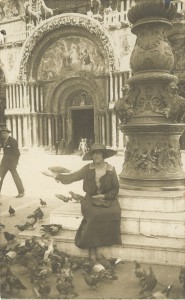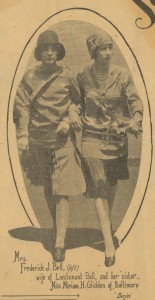
My mother used to say, wistfully, “You’re always writing about your father’s family; I wish you would write about mine.” Vita Brevis readers will remember the posts on my Great-Grandfather Glidden and the fruitful search for his photograph; with this post, I trust I will begin paying down the arrears on my mother’s mother’s mother’s family, the Bouchers.
My great-grandmother Pauline Boucher (1875–1964) was the sixteenth of the twenty-three children born in Baltimore to her father, William Boucher, Jr. (1822–1899), and the seventh of the fourteen born to her mother, Mary Frances (Giles) Boucher (1843–1923). While the size of the family is impressive, I should note that about half the children died young, and only one child of Boucher’s first marriage (to Mary Agnes O’Brien) lived to grow up and marry. This was Francis Xavier Boucher (1854–1927), who was thirty-three years older than the last-born child, Constance Marie (Boucher) Burch (1887–1977). Nine of the Boucher children married, but only five – Frank Boucher, Josephine Stone, Gertrude Donovan, Pauline Glidden, and Constance Burch – have living descendants.
Some of this I knew from my mother and her father, but what neither of them ever mentioned – because I think neither one knew – was that the musical instruments sold in William Boucher’s Baltimore Street shops appreciably changed the tenor of American popular music during the nineteenth century. Within a decade of his arrival from Germany, the Boucher banjo was spreading out across the Mid-Atlantic States, a truly portable musical instrument which appeared in paintings by William Sidney Mount (1856) and Eastman Johnson (ca. 1859).

Like her father, brother, and sister, my maternal grandmother was an accomplished artist, and the family tended to focus on their (extremely unlikely) connection to the painter François Boucher, who has no descendants in the male line. I am more struck by the musical talent in the family, including William Boucher (who wrote a rather heavy Verbena Waltz, a copy of which is in the Library of Congress); his son Frank – who famously could play every instrument in his shop in Washington, D.C. – and daughter Florence Estella Boucher (1879–1972); his granddaughters Dorothee (Boucher) Trewhella (1898–1993) and Constance Maria (Burch) Plummer (1914–2002) – not to mention my sister Dinah Steward!
An exhibit featuring William Boucher, Jr., and the Boucher banjos recently opened at the Baltimore Museum of Industry. I am hoping to visit the show, which focuses on the sudden popularity of minstrel music in the mid-nineteenth century, before it closes in October. I hope also to organize a reunion of William’s descendants during the show, and I will be writing more about it as a committee of Boucher cousins identifies and begins contacting modern-day members of the Boucher, Stoutenburgh, Trewhella, Stone, Donovan, Glidden, and Burch families.
The series continues here.
It is interesting how one side of the family gets the attention. In my case, my father’s side of the family was just easier with information more available. The Internet has changed that for the better.
Exactly. My father’s family was from Massachusetts and New York, and had been covered in print (and by my great-aunt’s research); my mother’s family was from Virginia and Maryland, and for many years I could find almost nothing in print about them. The ability to research remotely and then visit repositories with a sense of what the collection held changed things, vastly for the better.
Which Great Aunt? Am I related?
Laura
Yes, Margaret Steward.